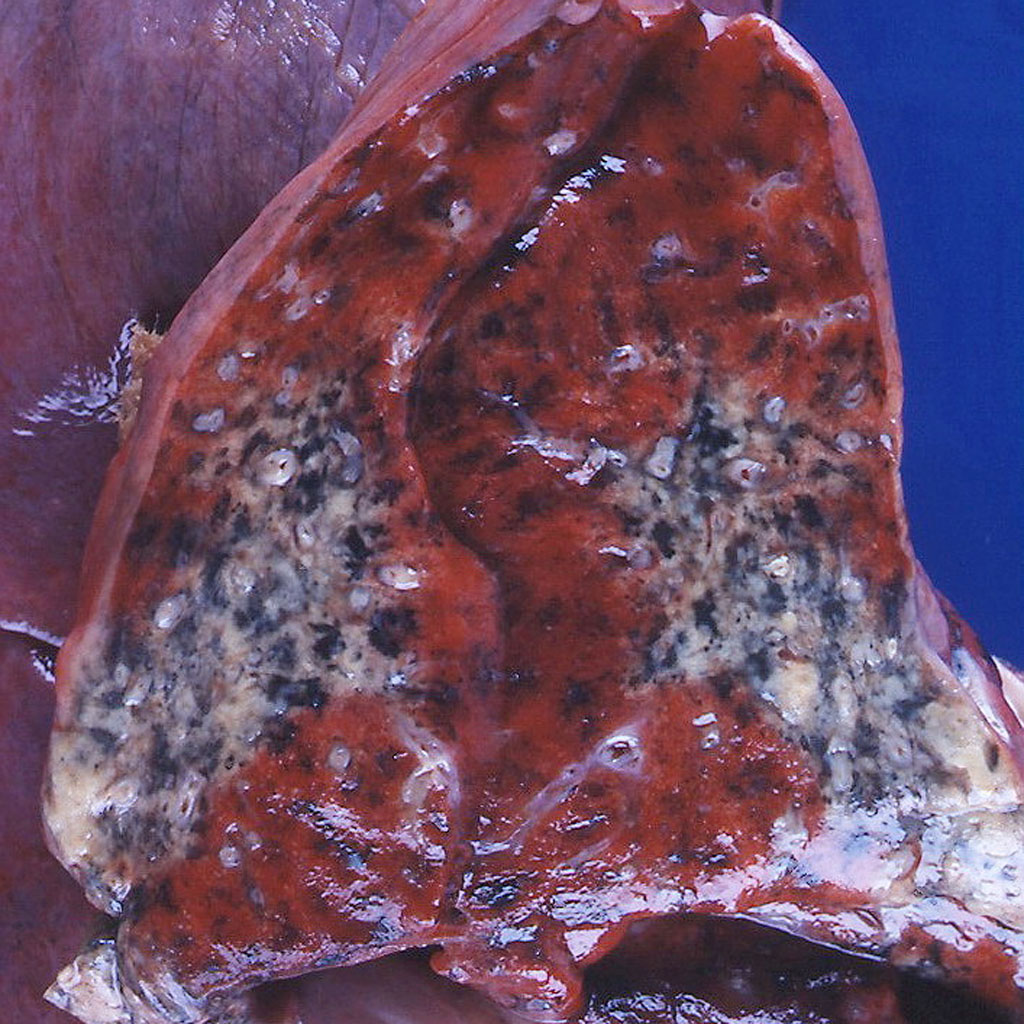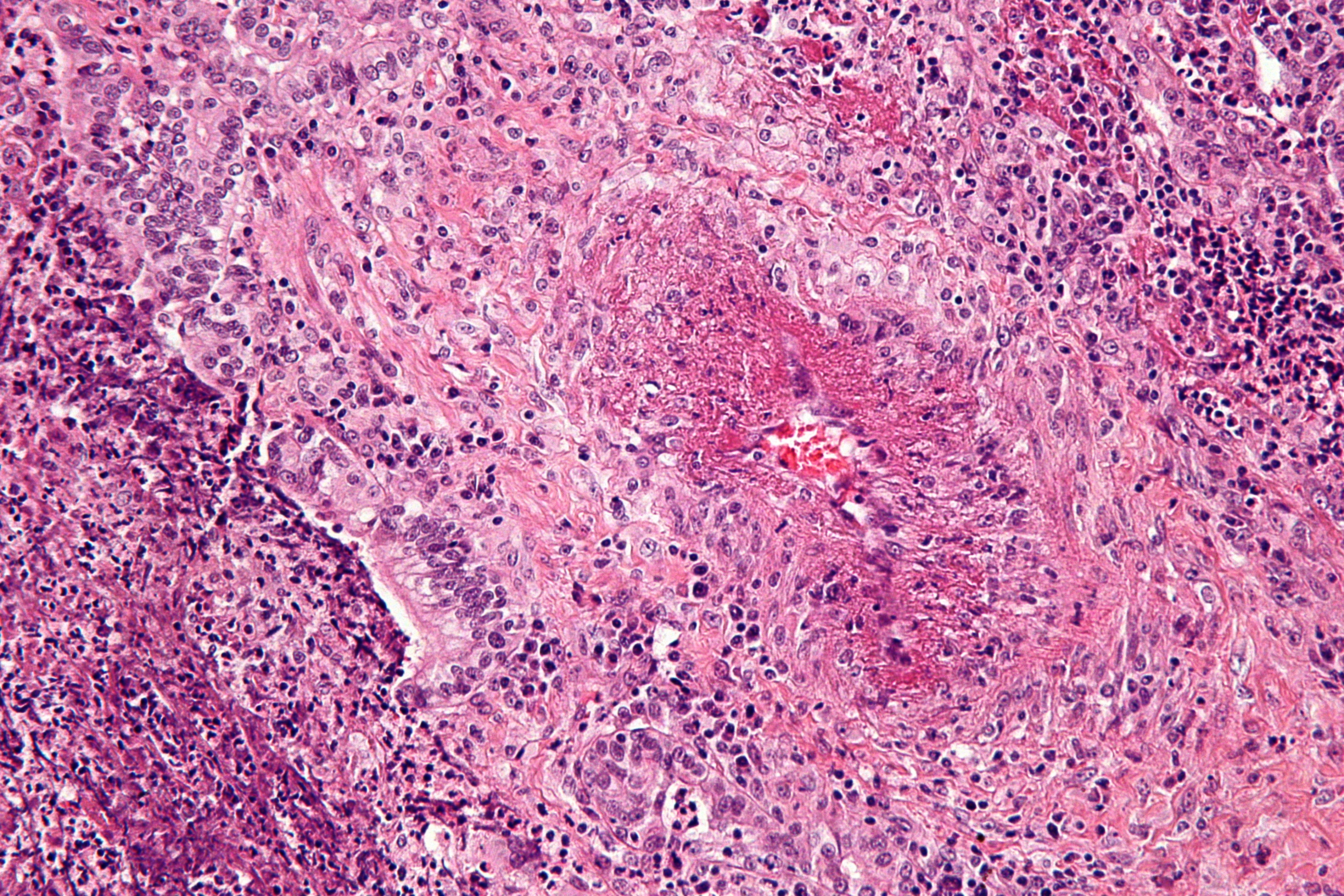|
Granulomatosis with polyangiitis Microchapters |
|
Differentiating Granulomatosis with polyangiitis from other Diseases |
|---|
|
Diagnosis |
|
Treatment |
|
Case Studies |
|
Granulomatosis with polyangiitis pathophysiology On the Web |
|
American Roentgen Ray Society Images of Granulomatosis with polyangiitis pathophysiology |
|
Granulomatosis with polyangiitis pathophysiology in the news |
|
Directions to Hospitals Treating Granulomatosis with polyangiitis |
|
Risk calculators and risk factors for Granulomatosis with polyangiitis pathophysiology |
Editor-In-Chief: C. Michael Gibson, M.S., M.D. [1]Ali Poyan Mehr, M.D. [2] Associate Editor(s)-in-Chief: Amandeep Singh M.D.[3]Krzysztof Wierzbicki M.D. [4]Cafer Zorkun, M.D., Ph.D. [5]Amandeep Singh M.D.[6]
Overview[edit | edit source]
The pathogenesis of granulomatosis with polyangiitis is currently unknown. However, several hypothesizes have been made to identify possible links associated with this disease, such as bacterial infections, failure of B-cells to downregulate, and T cell dysfunction. The genetic component of granulomatosis with polyangiitis is not fully known. However, there seems to be a strong correlation between HLA-DPB1 and HLA-DPB2 with granulomatosis with polyangiitis.
Pathogenesis[edit | edit source]
The pathogenesis of granulomatosis with polyangiitis is currently unknown. However, several suggestions have been made to identify possible links associated with the disease, such as bacterial infections, failure of B-cells to downregulate, and T cell dysfunction.
Role of bacterial antigens[edit | edit source]
- Bacterial infections invoke granulomatosis with polyangiitis by: causing granulocytes to become active, forming autoantibodies against microbial antigens and host proteins.[1]
Role of auto-immunity[edit | edit source]
- Another possible cause of this disease is the failure of B cells to downregulate ANCA autoimmunity because of CD19 dysregulation at two stages.
- The first is CD19 naïve B cells, the dysregulation of CD19 B naïve cells may result in B cells to be autoreactive and have the ability to activate themselves.
- Another stage of dysregulation is CD19 memory B cells, this allows increased sensitive to reactivate B cells.[2]
Dysfunction of T regulator cells[edit | edit source]
- The last pathogenic cause of ANCA is the dysfunction of T regulator cells (CD4+ CD25+). An imbalance between effector cells and regulatory T cells invokes the development of ANCA.
- The presence of ANCA, induces Interleukin 23 (Il-23) to produce T helper 17 cells. The production of T helper 17 cells promotes the production of Il-17, IL-6, and tumor necrosis factor alpha (TNF-α) which invokes the inflammation of cytokines. [3]
Neutrophil activation[edit | edit source]
- The inflammation due to cytokines and the presence of ANCA allows neutrophils to bind TNFα that are actively present on the endothelium, ANCA can cause neutrophils to become active.
- This is due to fragment secondary antibodies of ANCA that bind to proteinase 3 or myeloperoxidase.
- The Fragment crystallizable (Fc) binds to the Fragment crystallizable- gamma receptor (Fc-γ) which allows neutrophils to become active. With this activation, the endothelium becomes destroyed. This is due to degranulation and reactive oxygen species. [4]
Genetics[edit | edit source]
- The genetic component of granulomatosis with polyangiitis is not fully known.
- However, there seems to be a strong correlation between HLA-DPB1 and HLA-DPB2 with granulomatosis with polyangiitis.[5]
- The genetic inheritance of Granulomatosis with polyangiitis is not common.[8]
Associated Conditions[edit | edit source]
The following conditions are associated with Granulomatosis with polyangiitis:
- Subacute infective endocarditis[9]
- Goodpasture syndrome[10]
Gross Pathology[edit | edit source]
- On gross pathology, following are non specific findings in Granulomatosis with polyangiitis:[11]
- Ulceration
- Necrosis of bone and cartilage
- Vascular necrosis
Granulomatosis with polyangiitis-Case courtesy of Dr. Yale Rosen[12]
Granulomatosis with polyangiitis- By Yale Rosen from USA [13]
Microscopic Pathology[edit | edit source]
- On microscopic histopathology analysis,the characteristic findings of GPA are:are characteristic findings of Granulomatosis with polyangiitis.[14][15]
- Focal and segmental necrotizing glomerulitis
- Presence of non-caseating granuloma
- Necrotizing vasculitis
- Varied multinucleated giant cells at times
Granulomatosis with polyangiitis[16]
References[edit | edit source]
- ↑ Kain R, Exner M, Brandes R, Ziebermayr R, Cunningham D, Alderson CA; et al. (2008). "Molecular mimicry in pauci-immune focal necrotizing glomerulonephritis". Nat Med. 14 (10): 1088–96. doi:10.1038/nm.1874. PMC 2751601. PMID 18836458.
- ↑ Culton DA, Nicholas MW, Bunch DO, Zhen QL, Kepler TB, Dooley MA; et al. (2007). "Similar CD19 dysregulation in two autoantibody-associated autoimmune diseases suggests a shared mechanism of B-cell tolerance loss". J Clin Immunol. 27 (1): 53–68. doi:10.1007/s10875-006-9051-1. PMID 17195045.
- ↑ Noone D, Hebert D, Licht C (2016). "Pathogenesis and treatment of ANCA-associated vasculitis-a role for complement". Pediatr Nephrol. ( ): . doi:10.1007/s00467-016-3475-5. PMID 27596099.
- ↑ van Rossum AP, Limburg PC, Kallenberg CG (2005). "Activation, apoptosis, and clearance of neutrophils in Wegener's granulomatosis". Ann N Y Acad Sci. 1051 ( ): 1–11. doi:10.1196/annals.1361.041. PMID 16126939.
- ↑ Xie G, Roshandel D, Sherva R, Monach PA, Lu EY, Kung T; et al. (2013). "Association of granulomatosis with polyangiitis (Wegener's) with HLA-DPB1*04 and SEMA6A gene variants: evidence from genome-wide analysis". Arthritis Rheum. 65 (9): 2457–68. doi:10.1002/art.38036. PMC 4471994. PMID 23740775.
- ↑ https://ghr.nlm.nih.gov/condition/granulomatosis-with-polyangiitis#sourcesforpage
- ↑ Jagiello P, Gencik M, Arning L, Wieczorek S, Kunstmann E, Csernok E, Gross WL, Epplen JT (April 2004). "New genomic region for Wegener's granulomatosis as revealed by an extended association screen with 202 apoptosis-related genes". Hum. Genet. 114 (5): 468–77. doi:10.1007/s00439-004-1092-z. PMID 14968360.
- ↑ Knight A, Sandin S, Askling J (2008). "Risks and relative risks of Wegener's granulomatosis among close relatives of patients with the disease". Arthritis Rheum. 58 (1): 302–7. doi:10.1002/art.23157. PMID 18163522.
- ↑ Langlois V, Lesourd A, Girszyn N, Ménard JF, Levesque H, Caron F; et al. (2016). "Antineutrophil Cytoplasmic Antibodies Associated With Infective Endocarditis". Medicine (Baltimore). 95 (3): e2564. doi:10.1097/MD.0000000000002564. PMC 4998285. PMID 26817911.
- ↑ Kalluri R, Meyers K, Mogyorosi A, Madaio MP, Neilson EG (1997). "Goodpasture syndrome involving overlap with Wegener's granulomatosis and anti-glomerular basement membrane disease". J Am Soc Nephrol. 8 (11): 1795–800. PMID 9355084.
- ↑ WALTON EW (1958). "Giant-cell granuloma of the respiratory tract (Wegener's granulomatosis)". Br Med J. 2 (5091): 265–70. PMC 2026251. PMID 13560836.
- ↑ Case courtesy of Dr. Yale Rosen. https://radiopaedia.org/cases/8950 Accessed on March 29, 2018
- ↑ (Wegener's granulomatosis Uploaded by CFCF) [CC BY-SA 2.0 (https://creativecommons.org/licenses/by-sa/2.0)]
- ↑ Lie JT (1990). "Illustrated histopathologic classification criteria for selected vasculitis syndromes. American College of Rheumatology Subcommittee on Classification of Vasculitis". Arthritis Rheum. 33 (8): 1074–87. PMID 1975173.
- ↑ Muller K, Lin JH (2014). "Orbital granulomatosis with polyangiitis (Wegener granulomatosis): clinical and pathologic findings". Arch Pathol Lab Med. 138 (8): 1110–4. doi:10.5858/arpa.2013-0006-RS. PMC 4140401. PMID 25076302.
- ↑ Libre pathology. https://librepathology.org/wiki/Granulomatosis_with_polyangiitis Accessed on March 29, 2018

.jpg)
